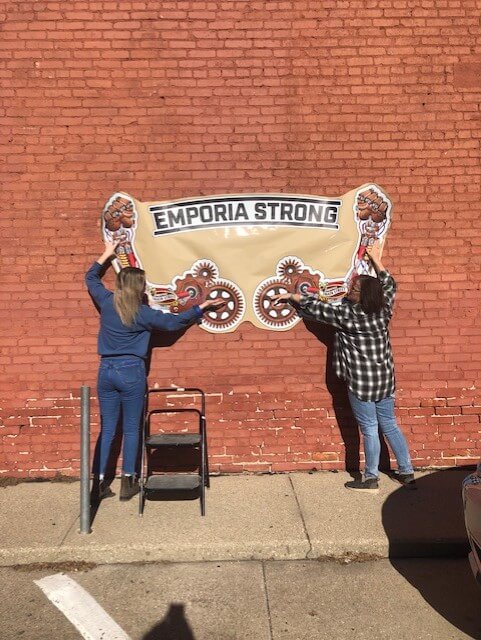
The Kansas Main Street network offers several different specialized trainings on topics relevant to community and economic development. Talking to area specialists on specialized topics can give us a better idea on strategies to pursue, while learning from the mistakes of others. The Emporia Main Street downtown mural project has been a great success, but we can always learn more from art practitioners. Below are some of our lessons learned from a recent conference:
- Why should communities develop murals?- Murals are a way to celebrate our culture, highlight important parts of our region, and create public interaction. When done well, murals create a focal point that the community can rally behind. Murals can also take advantage of large areas that could be converted to a canvas (like grain silos) or they can convert an unattractive area to something more inviting (like an underpass) through a concept we Main Streeters like to call “Design by Distraction”. Murals should never be applied to the business frontage of a commercial building, but underutilized areas, side walls, rear walls, or large solid spaces could be a potential spot for a community mural.
- All murals are temporary.- We would like to believe that public art lasts forever, but nothing lasts forever. The lifespan of good public art is 20-25 years, and the art will only last that long if it was done properly (more on that below). The object shouldn’t be the continual restoration of outdoor murals, but the recognition that this particular artform can be changed or replaced over time.
- Materials matter!- We cannot emphasize this enough: If brick or stone hasn’t been painted on, DON’T PAINT IT! Brick has a hard exterior shell with a soft interior. As the temperature and moisture changes, brick needs to “sweat”. When materials impede that process, the interior of the brick can swell can crack the hard exterior in a process called “spalling“. Spalling brick can lead to wall destabilization and REALLY expensive repairs. There are other types of materials that also shouldn’t be painted on, but there are workarounds to help put murals on buildings without damaging structures.
- If I can’t paint brick, does that mean I can’t have a mural on my brick building?- There are alternatives. Emporia Main Street partnered with Coffelt Sign Company to produce a temporary mural printed on a thin aluminum sheet. The sheet is heat applied to a building, and then can be removed at the end of its useful life (around 18 months to 2 years). For larger areas, products like “Poly Tab” from companies like QST Industries can be used. Large sheets can be applied to building exteriors, allowing artists to paint on the ground after the product has primer applied, and then the Poly Tab sheets can be applied to a building exterior. The application process is quicker and safer than most traditional mural applications.
- Community involvement is key to good public art.- Technical specifications are only part of the mural story; what should you paint? Anyone who has engaged “art by committee” knows what a nightmare that can be. If you have art that appeals to everyone, it becomes bland enough that it doesn’t resonate over time with anyone. However, if you have art in mind that appeals to a certain topic (community history, current popular items, a segment of the existing town, agricultural heritage, a holiday, etc.) you should probably get feedback from that target group prior to executing a large mural with decades of staying power. Finding mural artists with experience in murals of a certain type is important to stay consistent with your target theme. How do you find a mural artist that reflects the message you are trying to convey? You can start by contacting the Kansas Creative Arts Industry Commission (KCAIC).
- Can community members (non-artists) help paint murals?- If planned correctly, community members can offer more than input. The use of the Poly Tab material referenced above can allow for a “paint by numbers” planning approach that allows the public to help paint a mural. Public involvement can lengthen the time associated with a mural, but it also increases community buy-in of the project.
- How do murals get paid for?- Generally murals require a mixture of public and private funding options. Individual donors, community foundations, business interests, and individual citizens can partner with the KCAIC for funding (CLICK HERE). The KCAIC can offer much more than funding, and they have a resource page they are adding amenities to that enhance the mural development process (CLICK HERE).
- Murals are not signs.- Communities have sign ordinances for good reasons. Names of businesses change in buildings, overly signed areas can get too full of visual junk for consumers to absorb, and natural changes can lead to painting over part or all of a mural which can cause public backlash and accelerate negative consequences of painting. Art is art, and signs are signs. If you could picture your mural on a highway billboard, it’s probably a sign.
- Property owners need to have formal agreements with mural artists and agencies supporting them.- Some murals come with various degrees of building risk. Is any type of upkeep required for the mural? What happens if work on the mural wall (structural) needs to happen? Formal contracts that answer basic questions are important to facilitate good relationships between building owners and mural art creators.
Now that you have some mural basics, how would you like to engage the mural process? Are you a building/property owner, donor, artist, or supplier that could aid in local mural development? There are groups in Emporia focused on murals, and property owners that have expressed a desire for murals placed on their property. Contact Emporia Main Street if you have questions or need connected!